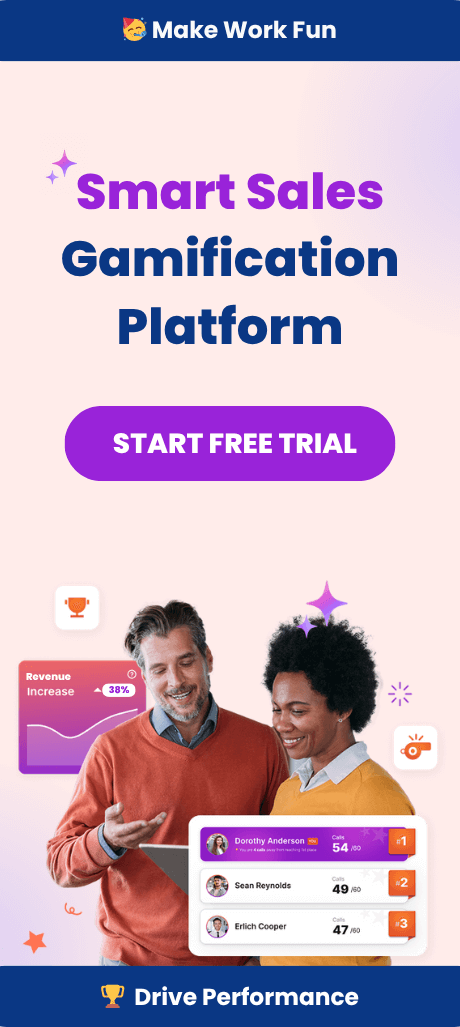Gamification’s New Direction in Sales Teams
Modern sales teams are no strangers to competition—targets, rankings, and rewards have long shaped the rhythms of every quarter. Yet, over the past several years, gamification has evolved rapidly from simple contests to a nuanced discipline built around behavioral science, digital engagement, and performance intelligence. Today, the question facing many leaders is not whether gamification can work, but how it should work to align with shifting team dynamics, new technology, and the realities of a hybrid (increasingly digital) sales environment.
The Strategic Shift: From Motivation to Engagement
For many executive leaders, gamification first appeared as a tactical lever—run a contest, watch metrics spike. But, as research in motivation and engagement has matured, so too has the understanding that sustainable performance does not come from one-off competitions. True value emerges from systems that build day-to-day engagement, foster learning, promote well-being, and celebrate both individual and team success.
This strategic reframing means that sales gamification is no longer about extrinsic motivators alone (prizes, public rankings), but about intrinsic engagement: the sense of meaning, belonging, and mastery that keeps high-performing teams resilient and goal-focused, even as markets shift. The current direction is toward platforms, processes, and performance frameworks that blend reward with recognition, skill-building, transparency, and long-term development.
Digital Leaderboards: More Than Just Numbers
The digital leaderboard has become the symbolic heart of many modern gamification initiatives. However, recent years have forced executives to rethink the traditional design and psychological impact of leaderboards. Static top-10 lists, for instance, often disengage those not in contention and can even foster unhealthy rivalry. Modern solutions now prioritize:
- Customizable views for individuals, teams, and regions
- Dynamic metrics beyond just sales volume—such as calls made, customer engagement, learning achievements, and peer recognition
- Personalized progress tracking that celebrates incremental improvement, not just the ‘winners’
- An inclusive structure that highlights diverse contributors and incentivizes collaborative behavior
This approach is discussed in detail in Spinify’s insight on why customizable leaderboards inspire sales teams, where companies have reported measurable gains in engagement and reduced competition-related stress. The future of digital leaderboards lies in their capacity to yield data insights while also supporting well-being and a sense of community—qualities essential for hybrid and remote teams.
From Gamification to Gamified Performance Management
Many leaders now recognize that project-based or short-term competitions are outpaced by systems where gamification is integrated into performance management software. These platforms offer continuous feedback and coaching, transparent KPI tracking, and holistic achievement frameworks. Instead of tying rewards purely to sales KPIs, high-performing teams leverage gamification in ways that reinforce learning, adaptability, and collaboration. This pivot helps ensure that recognition is available for those making critical process improvements, mentoring new hires, or excelling in customer retention efforts.
When considering the transition to integrated employee gamification platforms, leaders are wise to assess tools that:
- Embed into existing workflows and CRMs with minimal friction
- Offer robust analytics for tracking engagement and individual development
- Allow for flexible contest design that supports diverse roles and goals
- Prioritize privacy and data security (especially in sectors like financial services and healthcare)
Spinify’s experience in modernizing gamification software, including features for tracking holistic KPIs and feedback loops, illustrates the importance of aligning game mechanics with broader business objectives. To view how this integration works in practice, book a demo and explore how leading organizations use customized recognition loops to drive sustained results.
The Influence of AI Gamification on Sales Effectiveness
Artificial intelligence is adding new dimensions to employee gamification platforms. With advanced analytics and machine learning, it is now possible to predict engagement dips, automate personalized nudges, and adapt game mechanics in real time to match each team’s evolving profile. AI-powered sales gamification can surface patterns not visible to the naked eye—such as when a rep needs a motivational boost, which rewards are most meaningful, or which behaviors best precede high-performing quarters.
This rise in intelligence brings several benefits:
- Hyper-personalized motivation based on behavioral trends and historical performance
- Real-time feedback loops that foster development at the moment of greatest impact
- Reduced bias in recognition, ensuring every contributor receives the right acknowledgment
- Predictive analytics for leadership teams to adjust contests, messaging, and rewards before disengagement takes root
AI-driven engagement is covered at length in Spinify’s publication on rethinking employee engagement via AI gamification, which outlines how early adopters are seeing gains in team morale, stress reduction, and sales velocity through smart automation and targeted recognition.
Employee Engagement: The Core KPI That Matters
While sales outcomes remain top of mind, the underlying engine is (as ever) engagement. Research by Gallup and others consistently demonstrates that highly engaged teams are more productive, more resilient in challenging markets, and have higher retention rates. Gamification works best not by upending your culture, but by strengthening the positive rituals that unite teams: transparent progress, regular peer and management recognition, and visible growth pathways.
Leading organizations use employee engagement platforms not just for contest management, but for ongoing pulse surveys, public recognition, and cross-team visibility. These tools can integrate with employee reward systems to celebrate large deals and process milestones alike. Teams with access to real-time feedback and transparent digital leaderboards have been shown to outperform those with static, one-directional recognition models.
Related insights can be found in the article the impact of employee recognition on retention and productivity, where real-world data connects the dots between celebration, loyalty, and sustained KPIs.
Designing Effective Gamification Programs: Lessons from the Field
Not all gamification platforms are created equal, and experienced executives know that design is everything. Ill-conceived contests (or poorly explained metrics) can breed resentment, disengagement, or sandbagging. The most effective programs emphasize:
- Clarity on what metrics matter and why—ensuring that KPIs are aligned with business strategy, not vanity
- Regular iteration based on feedback and evolving team needs, rather than a set-it-and-forget-it mentality
- Equitable opportunities: rotating prize categories, celebrating non-sales wins, and including every region or role in the fun
- Visibility into progress and recognition—making it easy for peers and managers to publicly acknowledge effort and results
Strategic leaders frequently consult their engagement analytics and listen to employee sentiment to fine-tune programs. A willingness to sunset contests that are not resonating, and to experiment with new formats, keeps energy fresh and signals a commitment to shared success.
Choosing the Right Employee Gamification Platform
Selecting the best gamification platform is a high-stakes decision for any sales organization seeking both rapid gains and sustained transformation. Executive buyers should prioritize:
Integration Capabilities
Modern platforms must integrate with CRMs, performance dashboards, and communication tools such as Slack or Teams. The more seamless the user experience, the faster teams adopt the new approach.
Analytics and Reporting
Advanced analytics should make it simple to pinpoint which game mechanics offer the biggest return and where interventions are needed. Silent disengagement is a risk in remote-first teams, so a platform with visibility into ‘unseen’ contributors (not just top performers) is crucial.
Customization and Scalability
Different sales units, geographies, and skill levels call for flexible contest design. Choose a platform that allows for easy adaptation and growth—without requiring engineering hours every time you launch a new contest or reward.
Security and Compliance
Especially in verticals like financial services, ensure that your solution is compliant with SOC 2 or similar data standards. This assurance is no longer optional; it is table stakes for trust.
Spinify, for example, remains at the forefront by providing transparent pricing and free trial access for organizations keen to see real-world, secure engagement in action.
Gamification Programs as a Talent Retention Engine
Employee retention strategies increasingly depend on more than compensation. Today’s top performers—whether Gen Z or seasoned veterans—expect to feel valued, connected, and challenged. Gamification systems, when executed with care, reinforce a culture of achievement and visibility that makes every major and minor win matter. These platforms also empower leaders to spot and nurture emerging talent, to combat quiet quitting, and to build reputational momentum that attracts fresh prospects into the hiring funnel.
The exit interview is often too late to save a disengaged salesperson. Data-driven, gamified engagement means warning signals surface earlier, allowing managers and RevOps to proactively address burnout, disengagement, or blockers.
The Modern Metrics of Sales Gamification Success
What does success look like in this new era? The answer lies in a blend of traditional KPIs and modern engagement metrics:
- Increased participation in contests and recognition loops over time—not just a spike, but steady growth across quarters
- Rises in voluntary feedback, idea submission, and cross-team collaboration, indicating psychological safety and belonging
- Decline in voluntary turnover relative to competitive benchmarks, especially among high performers
- User adoption figures for gamification software, showing sustained logins and interaction throughout each week
- Tangible business results, such as sales velocity, pipeline coverage, and customer renewal rates—all improving in concert with engagement indicators
Modern performance dashboards increasingly link these datasets, empowering teams to connect dots and refine strategy at every level.
Looking Ahead: The Future of Sales Team Gamification
As the pace of business accelerates and hybrid work becomes the norm, ongoing innovation in gamification is a competitive necessity. Expect to see even deeper personalization, where every rep sees their unique path to mastery; smarter integrations with AI, reducing administrative load and surfacing coaching opportunities in real time; and richer, community-focused rituals that celebrate collaboration over cutthroat competition.
In the end, the future belongs to those teams with the most resilient engagement playbooks—those capable not only of chasing quotas, but of building vibrant performance cultures that turn every opportunity into a shared victory.



